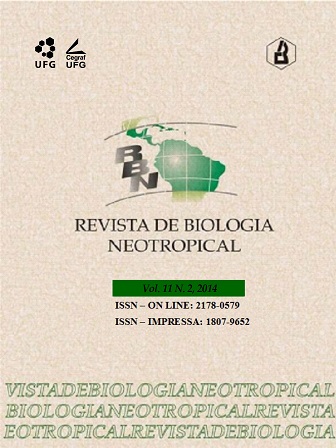Influence of environmental temperature on the establishment of adults of Chrysoperla externa (Hagen,1861) (Neuroptera: Chrysopidae)
DOI:
https://doi.org/10.5216/rbn.v11i2.29154Keywords:
Mass production, Green lacewing, Oviposition, TemperatureAbstract
Chrysoperla externa (Hagen, 1861) has great importance in studies of agricultural pest control, however, the success of it mass production depends on several factors, among which we canhighlight the temperature of the rearing environment. Aiming to discover the influence of environmen- tal temperature on the reproductive potential and survival of C. externa, pre-oviposition period, daily number of eggs per female, egg viability and mortality of adults of C. externa couples in three differenttemperatures: 18°C ± 1, 25 ± 1°C and ambient temperature (mean of 21.8 ± 2°C) were compared.Three replicates of ten couples per treatment were made, with each couple maintained in a breeding cage. WThe temperature of the environment in which C. externa adults were reared interfered with their reproductive potential, because with increasing temperature the pre-oviposition decreased, the numberof eggs per female and the daily egg viability increased, however, mortality of adults was not significantly different.
Downloads
References
Albuquerque, G. S., C. A. Tauber & M. J. Tauber. 1994. Chrysoperla externa (Neuroptera: Chrysopidae): life history and potencial for biological control in Central and South America. Biological Control. 4: 7-13.
Barbosa, J. C., E. B. Malheiros & D. A. Banzatto. 1992. ESTAT: um sistema de análises estatísticas de ensaios agronômicos. Versão 2.0. Jaboticabal: Unesp.
Brooks, S. J. 1997. An overview of the current status of Chrysopidae (Neuroptera) systematic. Deutsche Entomologische Zeitschrift. 44: 267-275.
Brooks, S. J. & P. C. Barnard. 1990. The green lacewings of the world: a generic review (Neuroptera: Chrysopidae). The bulletin of the British museum (Natural History). 59: 117-286.
Butler Jr., G. D. & P. L. Ritchie Jr. 1970. Development of Chrysopa carnea (Neuroptera: Chrysopidae) at constant and fluctuating temperatures. Journal of Economic Entomology. 63: 1028-1030.
Carvalho, C. F. & B. Souza. 2000. Métodos de criação e produção de crisopídeos. p. 91-109. In: V.H.P. BUENO, (Ed.). Controle biológico de pragas: produção massal e controle de qualidade. Lavras, UFLA.
Chang, YIN-FU., M. J. Tauber & C. A. Tauber. 1995. Storage of the mass-produced predator Chrysoperla carnea (Neuroptera: Chrysopidae): influence of photoperiod, temperature, and diet. Biological Control. 24: 1365-1374.
Chapman, R. F. 1998. The insects: structure and function. 4.ed., University Press, Cambridge, Harvard.
Figueira, L. K., C. F. Carvalho & B. Souza. 2002. Influência da temperatura sobre alguns aspectos biológicos de Chrysoperla externa (Hagen, 1861) (Neuroptera: Chrysopidae) alimentada com ovos de Alabama argillacea (Hübner, 1818) (Lepidoptera: Noctuidae). Ciência e Agrotecnologia. 26: 1439-1450.
Figueira, L. K., C. F. Carvalho & B. Souza. 2000. Biologia e exigências térmicas de Chrysoperla externa (Hagen, 1861) (Neuroptera: Chrysopidae) alimentada com ovos de Alabama argillacea (Hübner, 1818) (Lepidoptera: Noctuidae). Ciência e agrotecnologia. 24: 319-326.
Fonseca, A. R., C. F. Carvalho & B. Souza. 2001. Capacidade predatória e aspectos biológicos das fases imaturas de Chrysoperla externa (Hagen, 1861) (Neuroptera: Chrysopidae) alimentada com Schizaphis graminum (Rondani, 1852) (Hemiptera: Aphididae) em diferentes temperaturas. Ciência e Agrotecnologia. 25: 251-263.
Freitas, S. 2001a. O uso de crisopídeos no controle biológico de pragas. FUNEP, Jaboticabal, São Paulo.
Freitas, S. 2001b. Criação de crisopídeos (Bicho lixeiro) em laboratório. FUNEP, Jaboticabal, São Paulo.
Marengo, J. A. & Valverde, M. A. 2007. Caracterização do clima do Século XX e Cenário de Mudanças de clima para o Brasil no Século XXI usando modelos do IPCC-AR4. Revista Multiciência. 8: 5-28.
Nakahira, K., Nakahara, R. & Arakawa, R. 2005. Effect of temperature on development, survival, and adult body size of two green lacewings, Mallada desjardinsi and Chrysoperla nipponensis (Neuroptera: Chrysopidae). Applied Entomology and Zoology. 40: 615-620.
New, T. R. 1991. Neuroptera. p. 525-542. In: CSIRO (Eds.). The insects of the Australia. New York, Cornell University.
Núñez, E. Z. 1988. Ciclo biológico e crianza de Chrysoperla externa y Ceraeochrysa cincta (Neuroptera: Chrysopidae). Revista Peruana de Entomologia. 31: 76-82.
Pappas, M. L., Broufas, G. D. & Koveos, D. S. 2008. Effect of temperature on survival, development and reproduction of the predatory lacewing Dichochrysa prasina (Neuroptera: Chrysopidae) reared on Ephestia Kuehniella eggs (Lepidoptera: Pyralidae). Biological Control. 45: 396-403.
Pessoa, L. G. A., M. V. Leite, S. De Freitas & G. C. Garbin. 2004. Efeito da variação da temperatura sobre o desenvolvimento embrionário e pós-embrionário de Ceraeochrysa paraguaria (Navás) (Neuroptera: Chrysopidae) Arquivos do Instituto Biológico. 71: 473-476.
Rojht, H., F. Budija, & S. Trdan. 2009. Effect of temperature on cannibalism rate between green lacewings larvae (Chrysoperla carnea [Stephens], Neuroptera, Chrysopidae). Acta agriculturae Slovenica. 93: 5-9.
Salvadori, J. R. & J. R. P. Parra. 1990. Efeito da temperatura na biologia e exigências térmicas de Pseudaletia sequax (Lepidoptera: Noctuidae), em dieta artificial. Pesquisa Agropecuária Brasileira. 25: 1693-1700.
Samson, P. R. & P. R. B. Blood. 1979. Biology and temperature relationships of Chrysopa sp., Micromus tasmaniae and Nabis capsiformis. Entomologia Experimentalis et Applicata. 25: 253-259.
Southwood, T. R. E. 1978. Ecological Methods with Particular Reference to the Study of Insect Populations. Methuen, Inc., London.
Downloads
Published
How to Cite
Issue
Section
License
The expontaneos submmition of the manuscript automaticaly implies in the cession of all patrimonial rights for the Journal of Neotropical Bilogy (RBN) after publication. The autor allow the right of first publication of the article to the RBN, under Creative Commons Attribution 4.0 (CC BY-NC 4.0) Licence.
There are garanties for the authors to the authorial and moral rights, for each one of the articles published by RBN, with permissions:
1. The use of article and contents for the education and researches.
2. The use of the article and their contents, linking to the Article on the web site of the RBN, allowing the divulgation on:
- institutional closed web (intranet).
- open access repositories.
3. Preparation and divulgation of the other publication derived from the article and its content, if there is citation of the original publication by RBN.
4. Make printed copies in small quatinties for personal use.

















